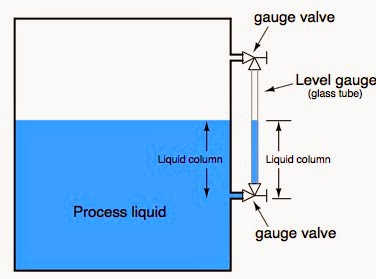The Magnetrol ECHOTEL utilizes ultrasonic energy to detect the presence or absence of liquid in a single or dual point transducer. Ultrasonic contact level technology uses high-frequency sound waves that are easily transmitted across a transducer gap in the presence of a liquid media, but are attenuated when the gap is dry. The ECHOTEL switches use an ultrasonic frequency of 2 MHz to perform this liquid level measurement in a wide variety of process media and application conditions.
The transducer uses a pair of piezoelectric crystals that are encapsulated in epoxy at the tip of the transducer. The crystals are made of a ceramic material that vibrates at a given frequency when subjected to an applied voltage. The transmit crystal converts the applied voltage from the electronics into an ultrasonic signal. When liquid is present in the gap, the receive crystal senses the ultrasonic signal from the transmit crystal and converts it back to an electrical signal. This signal is sent to the electronics to indicate the presence of liquid in the transducer gap. When there is no liquid present, the ultrasonic signal is attenuated and is not detected by the receive crystal.
For more information on industrial level control, contact M.S. Jacobs and Associates.
Sponsored by M.S. Jacobs & Associates, a manufacturer’s representative and distributor of industrial instrumentation, control valves & process controls. Located in Pittsburgh, Pa. and covering Western Pennsylvania, West Virginia, and New York. Representing top lines in pressure, temperature, level, flow, analytical instruments and industrial valves.
Telephone: 800-348-0089 or MSJacobs.com
Introduction to Level Measurement
In many industrial processes, the measurement of level is critical. Depending on the nature of the material being measured, this can be a simple or complex task. Several different technologies for sensing level are briefly explained here.
 |
| Gauge or Sightglass |
Level Gauges or Sightglasses
The simplest form of level measurement for direct measurement of level (almost always visually) in a vessel. A level gauge (sightglass) is usually a clear tube connected to the a vessel at the highest and lowest part of the level range. The fluid level inside the vessel will be at the same hight as the level in the tube.
Labels:
bubbler,
capacitance,
displacer,
echo,
float,
gauge,
hydrostatic,
level control,
sightglass,
ultrasonic
Control Valve Selection - 8 Things to Remember
 |
| Cashco Control Valve |
- Control valves are not intended to be a an isolation valve and should not be used for isolating a process.
- Always carefully select the correct materials of construction. Take into consideration the parts of the valve that comes in to contact with the process media such as the valve body, the seat and any other "wetted" parts. Consider the operating pressure and operating temperature the control valve will see. Finally, also consider the ambient atmosphere and any corrosives that can occur and effect the exterior of the valve.
- Put your flow sensor upstream of the control valve. Locating the flow sensor downstream of the control valve exposes it to an unstable flow stream which is caused by turbulent flow in the valve cavity.
- Factor in the degree of control you need and make sure your valve is mechanically capable. Too much dead-band leads to hunting and poor control. Dead-band is roughly defined as the amount of control signal required to affect a change in valve position. It is caused by worn, or loosely fitted mechanical linkages, or as a function of the controller setting. It can also be effected by the tolerances from mechanical sensors, friction inherent in the the valve stems and seats, or from an undersized actuator.
- Consider stiction. The tendency for valves that have had very limited travel, or that haven't moved at all, to "stick" is referred to as stiction. It typically is caused by the valves packing glands, seats or the pressure exerted against the disk. To overcome stiction, additional force needs to be applied by the actuator, which can lead to overshoot and poor control.
- Tune your loop controller properly. A poorly tuned controller causes overshoot, undershoot and hunting. Make sure your proportional, integral, and derivative values are set). This is quite easy today using controllers with advanced, precise auto-tuning features that replaced the old fashioned trial and error loop tuning method.
- Don't over-size your control valve. Control valves are frequently sized larger than needed for the flow loop they control. If the control valve is too large, only a small percentage of travel is used (because a small change in valve position has a large effect on flow), which in turn makes the valve hunt. This causes excessive wear. Try to always size a control valve at about 70%-90% of travel.
- Think about the type of control valve you are using and its inherent flow characteristic. Different types of valve, and their disks, have very different flow characteristics (or profiles). The flow characteristic can be generally thought of as the change in rate of flow in relationship to a change in valve position. Globe control valves have linear characteristics which are preferred, while butterfly and gate valves have very non-linear flow characteristics, which can cause control problems. In order to create a linear flow characteristic through a non-linear control valve, manufacturers add specially designed disks or flow orifices which create a desired flow profile.
Subscribe to:
Posts (Atom)